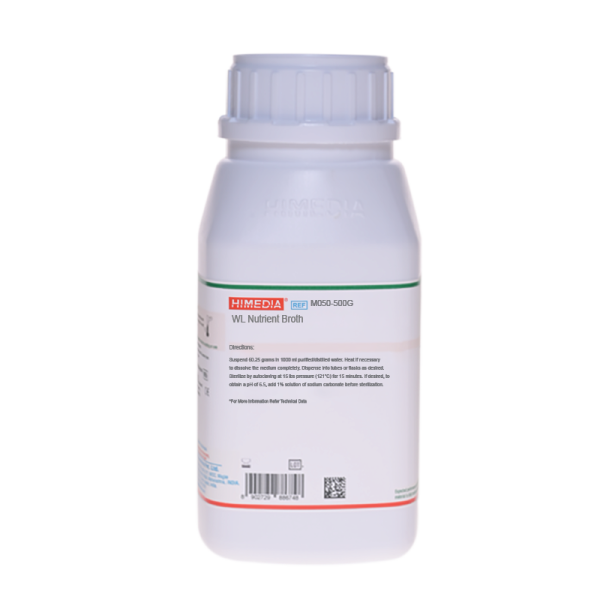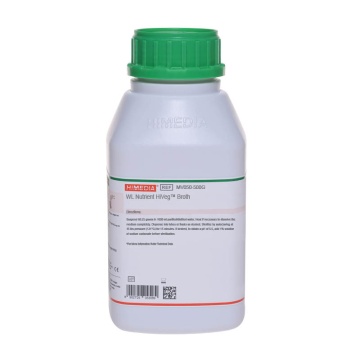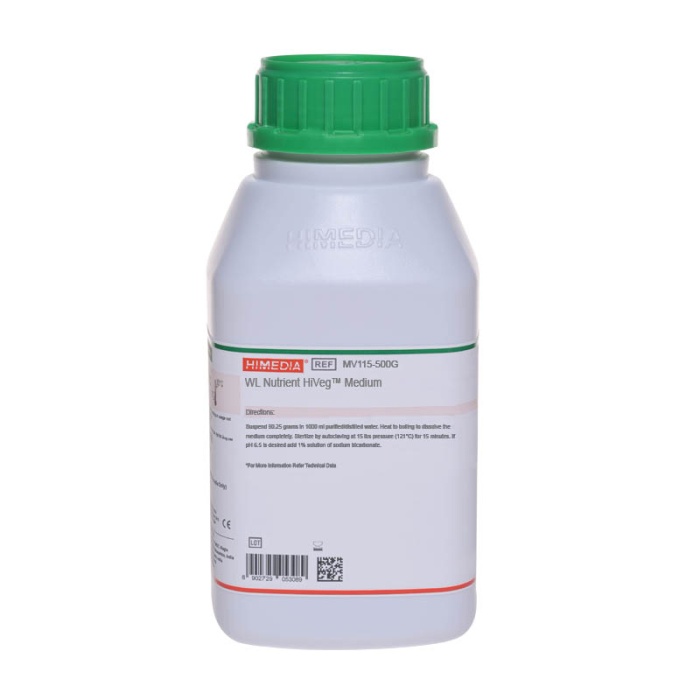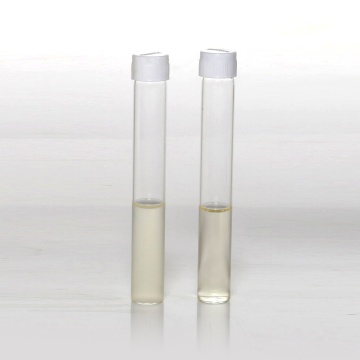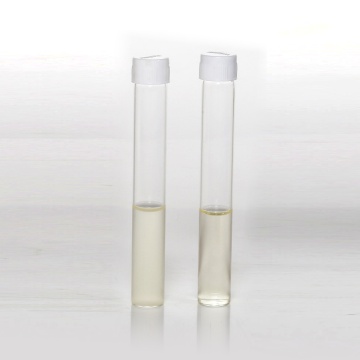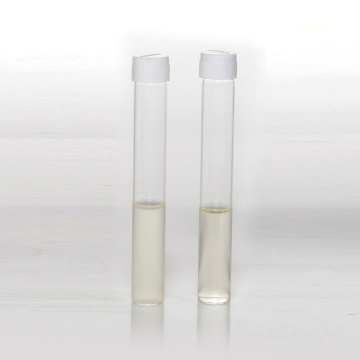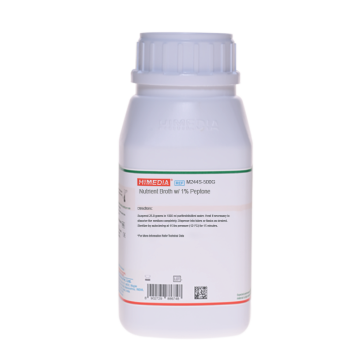 Your enquiry has been submitted
Your enquiry has been submitted
WL Nutrient Broth
Intended Use
Recommended for cultivation of yeasts, moulds and bacteria encountered in brewing and industrial fermentation processes.
Composition
| Ingredients | g/L |
|---|---|
| Tryptone | 5.000 |
| Yeast extract | 4.000 |
| Dextrose (Glucose) | 50.000 |
| Potassium dihydrogen phosphate | 0.550 |
| Potassium chloride | 0.425 |
| Calcium chloride anhydrous | 0.125 |
| Magnesium sulphate | 0.125 |
| Ferric chloride | 0.0025 |
| Manganese sulphate | 0.0025 |
| Bromo cresol green | 0.022 |
Final pH (at 25°C): 5.5±0.2
**Formula adjusted, standardized to suit performance parameters
Directions
Suspend 60.25 grams in 1000 ml purified / distilled water. Heat if necessary, to dissolve the medium completely. Dispense in tubes or flasks or as desired Sterilize by autoclaving at 15 lbs pressure (121°C) for 15 minutes. Cool to 45-50°C. If desired to obtain a pH of 6.5, add 1% solution of sodium bicarbonate before sterilization.
Principle And Interpretation
WL (Wallerstein Laboratory) media are formulated as described by Green and Gray for the examination of materials encountered in brewing and for industrial fermentations containing mixed flora of yeast and bacteria (1, 2). Bakers yeast counts can be carried out in this medium at a pH 5.5. By adjusting the pH to 6.5, the medium can be used for obtaining counts of Baker and distillers yeast (3). If desired Durham's tubes can be added to WL Nutrient Broth to study fermentation reactions.
Yeast extract serves as a source of trace elements, vitamins and amino acids. Tryptone is used as a source of nitrogen, amino acids and carbon. Dextrose is the source of carbohydrate. Buffering of the medium is done by monopotassium phosphate. Potassium chloride, calcium chloride and ferric chloride are essential ions that help to maintain the osmotic balance. Magnesium sulphate and manganese sulphate are sources of divalent cations. Bromo cresol green is a pH indicator.
Type of specimen
Microorganisms in brewery
Specimen Collection and Handling
For fermentation samples follow appropriate techniques for handling specimens as per established guidelines (1,2). After use, contaminated materials must be sterilized by autoclaving before discarding.
Warning and Precautions
Read the label before opening the container. Wear protective gloves/protective clothing/eye protection/ face protection. Follow good microbiological lab practices while handling specimens and culture. Standard precautions as per established guidelines should be followed while handling specimens. Safety guidelines may be referred in individual safety data sheets.
Limitations
- Further biochemical identification of organisms is required for confirmation.
Performance and Evaluation
Performance of the medium is expected when used as per the direction on the label within the expiry period when stored at recommended temperature.
Quality Control
Appearance: Ligth yellow to light green homogeneous free flowing powder
Colour and Clarity of prepared medium: Bluish green coloured very slightly opalescent solution in tubes.
Reaction: Reaction of 6.02% w/v aqueous solution at 25°C. pH : 5.5±0.2
pH: 5.30-5.70
Cultural Response
Cultural characteristics observed in tubes containing inverted Durham's tubes after an incubation at 35-37°C for 40-48 hours for bacteria and at 30-32°C upto 5 days for yeast.
| Organism | Inoculum (CFU) | Growth | Acid | Gas |
|---|---|---|---|---|
| Escherichia coli ATCC 25922 (00013*) | 50-100 | fair-good | positive reaction, yellow colour | positive |
| Lactobacillus fermentum ATCC 9338 | 50-100 | fair-good | positive reaction, yellow colour | slightly positive |
| Saccharomyces cerevisiae ATCC 9763 (00058*) | 50-100 | good | positive reaction, yellow colour | positive |
Key: *Corresponding WDCM numbers.
Storage and Shelf Life
Store between 10-30°C in a tightly closed container and the prepared medium at 15-30°C. Use before expiry date on the label. On opening, product should be properly stored dry, after tightly capping the bottle in order to prevent lump formation due to the hygroscopic nature of the product. Improper storage of the product may lead to lump formation. Store in dry ventilated area protected from extremes of temperature and sources of ignition Seal the container tightly after use. Product performance is best if used within stated expiry period.
Disposal
User must ensure safe disposal by autoclaving and/or incineration of used or unusable preparations of this product. Follow established laboratory procedures in disposing of infectious materials and material that comes into contact with sample must be decontaminated and disposed of in accordance with current laboratory techniques (4,5).
Reference
- Green S. R. and Gray P. P., 1950, Wallerstein Lab. Commun., 12:43
- Green S. R. and Gray P. P., 1950, Wallerstein Lab. Commun., 13:357
- MacFaddin J. F., 1985, Media for Isolation-Cultivation- Identification- Maintenance of Medical Bacteria, Vol.1, Williams & Wilkins, Baltimore, Md.
- Isenberg, H.D. Clinical Microbiology Procedures Handbook 2nd Edition.
- Jorgensen, J.H., Pfaller, M.A., Carroll, K.C., Funke, G., Landry, M.L., Richter, S.S and Warnock., D.W. (2015) Manual of Clinical Microbiology, 11th Edition. Vol. 1.
| Product Name | WL Nutrient Broth |
|---|---|
| SKU | M050 |
| Product Type | Regular |
| Physical Form | Powder |
| Origin | Animal |
| Packaging type | HDPE |
| References | 1. Green S. R. and Gray P. P., 1950, Wallerstein Lab. Commun., 12:43 2.Green S. R. and Gray P. P., 1950, Wallerstein Lab. Commun., 13:357 3.MacFaddin J. F., 1985, Media for Isolation-Cultivation- Identification- Maintenance of Medical Bacteria, Vol.1,Williams& Wilkins, Baltimore, Md. |
| Customized Product Available | No |



